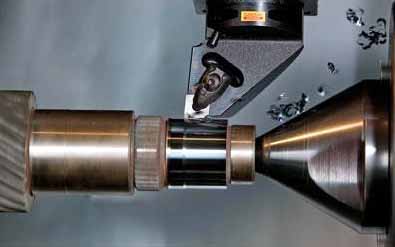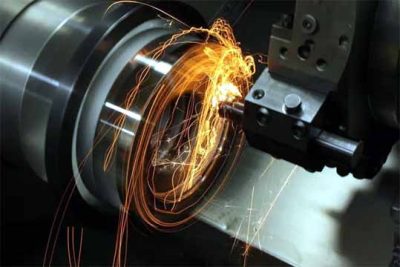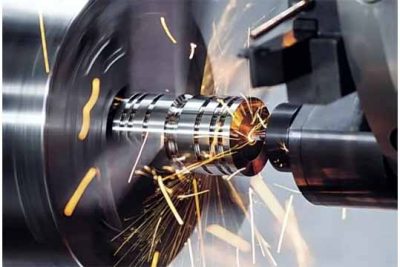Challenge: How to re-optimize hard material part turning?
Solution: Correct application of the latest turning insert grades and geometries based on existing operating data.

Turning chilled cast iron
Hard material turning (HPT) as a machining process has come a long way since it was widely promoted in the mid-1980s. Advances in machinery, part materials, quenching processes, cutting tools, and complete hard part turning setups have made hard part turning a highly efficient process that can be mastered by any shop.
The many benefits of hard part turning make it necessary to analyze most applications involving round hard parts. While hard part turning should not be considered a replacement for all grinding operations, 2 つのプロセスが相互に補完できるアプリケーションがいくつかあります.
立方晶窒化ホウ素によりサイクルタイムが短縮, 品質と生産効率の向上
硬質部品旋削の主な利点は次のとおりです。:
• 複雑な部品形状への適応が容易
• 複数のパートを素早く切り替える
• 1 回のセットアップで複数の操作を実行する機能
• 高い金属除去率
• 旋削加工の試運転に使用される計算機 CNC 旋盤を活用する機能
• 工作機械への投資が少ない
• 金属チップは環境に優しい
• ほとんどの場合、冷却剤は必要ありません。
• 工具の在庫と床面積を最小限に抑える
• 表面仕上げが有利になる傾向がある.

高硬度鋼ワークの旋削加工
立方晶窒化ホウ素 (CBN) ほとんどの用途の要件を満たしているため、硬質部品の旋削加工に最も広く使用されている工具材料です。. とても難しいです (ダイヤモンドに次ぐ) さまざまな靭性のブレードグレードと組み合わせることができます. 現在、次のような進化するプロセス要件を満たすために、新しく開発されたいくつかのグレードの CBN インサートが利用可能です。: 切断速度, フィード, 連続カットと断続カット, 表面仕上げ, およびさまざまな動作条件.
加工領域に集中する高い切削抵抗と高温の組み合わせにより、高い圧力が発生します。. したがって, 硬質部品の加工において, 工具摩耗の主な症状は、刃先のクレータ摩耗です。. 硬質立方晶窒化ホウ素は、適度な靭性を備えてこれらの要件を満たすことができる唯一の工具材料です. Recent developments in CBN grades have provided the means to further limit wear while also improving edge safety, expanding application range and increasing cutting speeds by around 20%.

Turning of superhard materials
Productivity, quality consistency and process reliability are the basic criteria for hard part turning today. As hard part turning has developed into a widely used process with the advantage of finishing parts after heat treatment, various demands have been made in terms of machining efficiency.
As productivity is an increasingly important factor in today’s hard part machining, tool development plays an important role. Trends include higher cutting speeds (over 200 m/min for some grades), longer tool life, and improved tool life predictability. Feed rates have also been increased, チップ強度と形状の開発により切削時間の短縮を実現.
今日の切削業界の運用要件を満たすために、インサートの硬化がますます望まれています。. 一般的に立方晶窒化ホウ素グレードが好まれます, 続いてセラミックグレード, さまざまなアプリケーションのニーズに合わせて最適化する:
・CB7015は安定した作業条件での連続切削から時々軽断続切削まで対応します。, 主に表面硬化鋼に使用されます.
• CB7025 は、長時間の連続切削から重度の断続フライス加工に適しています。. 多くの場合、プランジ条件が悪いことが特徴です, バリや面取りされていない角など, 主に焼き入れ鋼用.
・CB7050は部品の形状変化が大きく、歪みが激しい過酷な条件に適しています。, または傾斜のない休憩がある, 主に焼き入れ鋼用.
• GC6050 は、一部の加工において立方晶窒化ホウ素を補完するセラミックグレードであり、良好な条件での軽作業の連続仕上げに適しています。. 主に表面品質が重要ではない肌焼き鋼に使用されます。.
部品の中心線に平行または垂直に加工する場合, 表面硬化部品
硬い部品の旋削加工には、CB7015 シリーズの Xcel チップを使用してください。
インサート形状に関して, 硬質部品加工用インサートの刃先は、高い刃先強度が必要なため、比較的鈍くなっています。, しかし、これはジオメトリの問題が重要ではないという意味ではありません. While the chipbreaker is not part of the edge chamfering of the insert profile, the combination of honing, nose radius, wiper edge and lead angle is critical to performance and results.
Over the years, wiper insert technology has revolutionized turning finishing in general. It also improves hard part turning. 今日, specially developed wiper inserts are available for hard part turning finishing and semi-finishing operations with significantly higher feedrate capabilities than conventional nose radii.
The Xcel insert geometry is a further optimization of the feedrate/surface finish for hard part turning. It carefully balances a straight cutting edge with a small entry angle with wiper technology. This small lead angle accepts the lead angle of the main insert, which is slightly higher than the depth of cut value of the insert. It acts to thin the chips, allowing higher feed rates to be used. This will benefit productivity and help reduce insert wear at depth-of-cut boundaries. The Xcel concept reduces cutting temperatures and brings considerable productivity gains.
Hard Part Turning (HPT) is the CNC turning of high hardness workpieces. Typically, the hardness range for this process is 58 に 68 HRc. Workpiece materials include hardened alloy steel, tool steel, case hardened steel and heat treated powder metallurgy parts. It is mainly a finishing process, but it can also be a semi-finishing process, which requires high precision in size, shape and surface finish. These surfaces have traditionally been ground.
 English
English العربية
العربية 中文(漢字)
中文(漢字) Čeština
Čeština Dansk
Dansk Nederlands
Nederlands Suomi
Suomi Français
Français Deutsch
Deutsch Italiano
Italiano 日本語
日本語 ಕನ್ನಡ
ಕನ್ನಡ 한국어
한국어 Português
Português Русский
Русский Slovenčina
Slovenčina Español
Español Svenska
Svenska Türkçe
Türkçe

